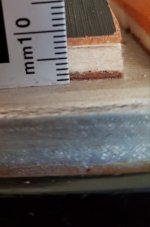Jigster
Newbie
I have an old Sonola R465 and aim to try carry out some keyboard work.
The white keys sit about 2 mm proud of the frame, although are level opposite the axle exit. Was it possibly manufactured this way?
The white keys really clatter when played -
The pallet facing (white felts / leather) are worn and some out of shape- the felt / leather facing on white keys is about 7mm and I guess probably nearer 8mm when new (probably 60+ years ago)- seems a lot? Thickest I've seen is about 6mm for replacement. The end of the pallet travels about 9mm. The black keys aren't so bad and look in better condition (less travel and thinner pallet facing).
I've included some pics and measurement.
All suggestions/advice very welcome and much appreciated. First time posting.
The white keys sit about 2 mm proud of the frame, although are level opposite the axle exit. Was it possibly manufactured this way?
The white keys really clatter when played -
The pallet facing (white felts / leather) are worn and some out of shape- the felt / leather facing on white keys is about 7mm and I guess probably nearer 8mm when new (probably 60+ years ago)- seems a lot? Thickest I've seen is about 6mm for replacement. The end of the pallet travels about 9mm. The black keys aren't so bad and look in better condition (less travel and thinner pallet facing).
I've included some pics and measurement.
All suggestions/advice very welcome and much appreciated. First time posting.



